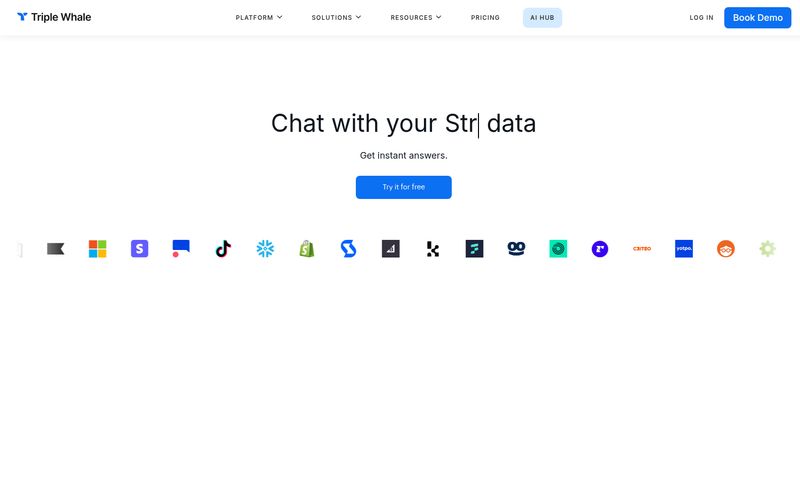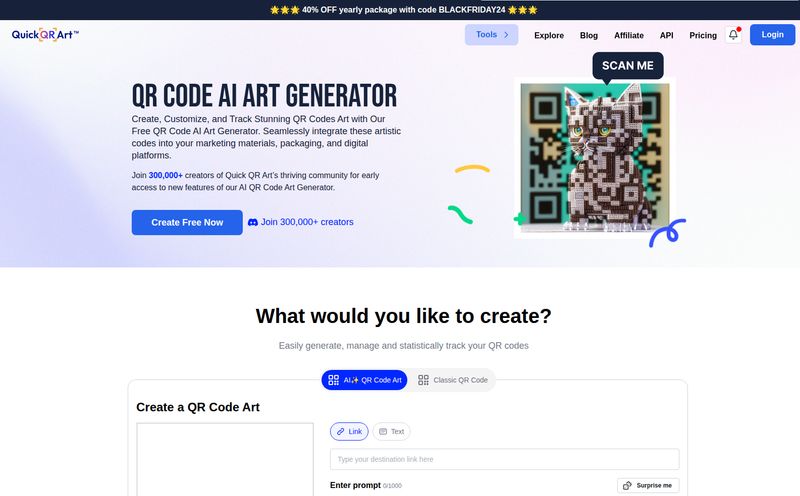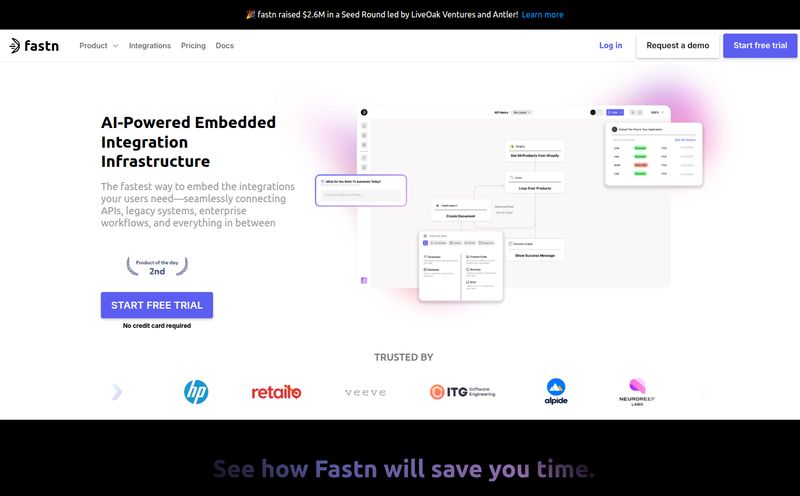The AI genie is out of the bottle, and it's currently writing half the internet's homework assignments. As someone who’s been watching traffic and search trends for years, I’ve seen the queries shift from "how to write an essay" to "best AI to write my essay for me." It’s a bit of a nightmare for educators, and frankly, a bit of a bummer for anyone who actually values learning.
Every week, it feels like a new AI-powered “something” lands in my inbox, promising to revolutionize… well, everything. Most of them are just shiny wrappers on the same underlying tech. So, when I stumbled upon a platform named FibonacciKu, I was ready to give it a polite nod and scroll on. But the tagline—a personalized AI learning assistant for teachers and students—made me pause. And their core mission? To be a study buddy that actively discourages cheating.
Okay, now you have my attention. An AI tool built with academic integrity in mind? That's not just a feature; it's a philosophy. It's like finding a unicorn in a field of horses. So, I decided to take a closer look.
So, What Exactly Is FibonacciKu?
At its heart, FibonacciKu isn't trying to be just another answer engine. It positions itself as a partner in the learning process. The whole vibe is less about spitting out a finished product and more about guiding you to an understanding. Think of it less like a calculator that gives you the number 4, and more like a patient tutor who walks you through why 2+2 equals 4 in the first place. The platform seems to be built on three core ideas: Explore, Learn, and Grow.
It's an integrated system, which I appreciate. Nothing worse than having to juggle three different platforms to get one thing done. Here, they've bundled everything into a suite of tools designed to work together. It's a bold move, trying to create a walled garden for learning, but I can see the appeal for a school or a teacher trying to maintain some control in this wild west of AI.
The Million-Dollar Question: Can It Stop AI Cheating?
This is the centerpiece, isn't it? The one thing that could make every teacher, professor, and administrator on the planet breathe a little easier. The rise of generative AI has thrown a massive wrench into traditional education. How do you assess a student's knowledge when they have a ghostwriter in their pocket? FibonacciKu's entire approach seems to be a direct response to this crisis.
Instead of just providing a perfectly polished paragraph on the human immune system, the Fibo Assistant, based on the interface I’ve seen, does something smarter. It gives a concise explanation and then immediately prompts the user with related questions and links. It nudges you to ask: How does the innate immune system work? How do vaccines work with your immune system? This is a subtle but powerful shift. It’s a Socratic personal trainer for your brain.
This method encourages curiosity and critical thinking, not just copy-pasting. Will some students still try to game the system? Of course. But a tool designed to foster understanding makes it a whole lot harder to just mindlessly cheat. It puts a little friction back into the process, and in this case, friction is a good thing.

Visit FibonacciKu
I also have to give them props for their honesty. Right there in the chat interface is a little disclaimer: "Fibonacci makes mistakes sometimes." I love this. It's a crucial reminder that these are tools, not oracles. It teaches students to be skeptical and to cross-reference information—a skill that is becoming more valuable by the day.
A Look Inside the FibonacciKu Toolkit
The platform isn't just one single chatbot. It’s broken down into a few key components that work in tandem.
Fibo Assistant: Your Personal Knowledge Navigator
This is the chat interface, the core interactive element. It's where students can ask questions and explore topics. From what I can gather, it's designed to be a starting point for inquiry, not an endpoint for answers. The real value seems to be in its ability to connect dots and suggest new avenues for exploration, pushing you deeper into a subject.
Fibo Book: A Curated Digital Library
This feature seems to work alongside the Assistant to provide relevant reading materials. Instead of just sending you off to the wilds of Google or Wikipedia, it pulls together resources to build a foundational understanding. For a student tackling a complex subject, having a pre-vetted set of materials could be a huge time-saver and help them avoid the noise of low-quality sources.
Fibo School: The Teacher’s Command Center
This is where the platform shows its potential for institutional use. Fibo School is the learning management side of things. It’s where a teacher can presumably integrate FibonacciKu into their curriculum, monitor student progress (in a non-creepy way, I hope), and manage the learning environment. For schools that go all-in, FibonacciKu even offers enterprise services like API access and help with digitalization. This shows they’re thinking bigger than just individual users; they’re thinking about system-wide adoption.
My Honest Take: The Good and The Not-So-Good
No tool is perfect, especially in the fast-moving world of AI. After digging around, I have a few thoughts.
What I really like is the philosophy. They've clearly thought about the pedagogical implications of AI and are trying to build something constructive. The focus on process over product is a huge win. It’s a refreshing change of pace from the “write me an email in a cheerful but firm tone” type of AI tool. The integrated nature of the Assistant, Book, and School is also very smart.
However, what gives me pause is the lack of transparency around pricing. The FAQ section on their site mentions, "You can use FibonacciKu for free with some restrictions, but you can upgrade to the Starter, Hobby or Writer plans..." That's great! But the link to the pricing page is... well, it’s not there. As of my review, it’s a ghost. For a B2B-facing company, this feels like a major oversight. It makes it hard to seriously evaluate it for adoption if you can't even see the price tags. It's a bit of a red flag that suggests the product might still be in a very early stage. Also, while the anti-cheating angle is brilliant, let's be realistic. No system is foolproof. A determined student will always find a workaround. But it’s about raising the bar, and that’s a worthy goal.
So, Who Is This Really For?
- For motivated students: If you genuinely want to learn and are looking for a tool to help you explore subjects deeply, this could be fantastic. It's a study aid that respects your intelligence.
- For forward-thinking teachers: For educators who want to embrace AI in the classroom but are terrified of its impact on academic honesty, FibonacciKu offers a compelling middle ground. It's a tool you can actually recommend without feeling like you're aiding and abetting.
- For schools and institutions: With enterprise features like API access and consultation, FibonacciKu is clearly courting educational institutions looking for a safe, integrated way to bring AI into their ecosystem.
Frequently Asked Questions about FibonacciKu
Is FibonacciKu free?
Yes, it appears to have a free version with some limitations. They mention paid plans like Starter, Hobby, and Writer for an enhanced experience, though details are not readily available on their site.
What does "Internet access" mean for the AI?
This typically means the AI can pull information from the current internet to provide up-to-date answers, rather than relying solely on its initial training data (which can be months or years old). This is crucial for topics in science, technology, and current events.
How does it compare to something like ChatGPT?
While both are AI assistants, their purpose is different. ChatGPT is a general-purpose tool that will often generate a complete answer or piece of text. FibonacciKu is a specialized educational tool focused on guiding the learning process and prompting further inquiry, rather than just handing over the final answer.
Can it really prevent cheating 100%?
No tool can guarantee that. However, by its very design—focusing on explanation, exploration, and Socratic questioning—it makes mindless cheating much more difficult and less rewarding than tools that simply write text on command.
What payment methods are available for upgrades?
Their website doesn't currently specify this. Most SaaS platforms typically accept major credit cards and possibly PayPal, but we'll have to wait for their official pricing page to be sure.
A Step in the Right Direction for AI in Education?
So, is FibonacciKu the magic bullet that will solve the AI problem in schools? Probably not. No single tool can do that. But is it a massive, thoughtful step in the right direction? Absolutely.
It’s one of the first platforms I've seen that doesn’t just chase the AI hype but actually stops to ask, “How can we use this technology to make learning better, not just easier?” They’re trying to teach students how to think, not just how to prompt. And by doing that, they might just help us teach that AI genie in the bottle some manners. If they can sort out their pricing transparency and continue to build on this solid foundation, FibonacciKu could become a truly valuable player in the future of edtech. I, for one, will be keeping an eye on them.



